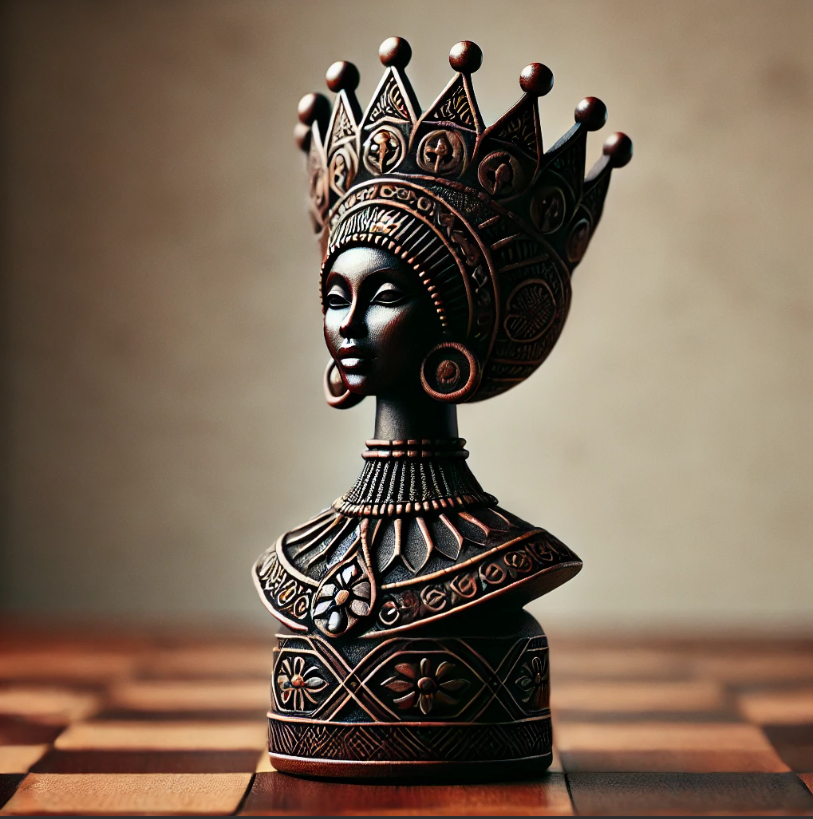Crown & Shadow: The Queen — Motion in All Directions
If the King is stillness, the Queen is speed, and in her lies the board’s true power.
By Germar Reed
In chess, the King is the center. But it is the Queen who carries the game.
She moves the farthest, the fastest. She crosses the board in sweeping lines, striking with both reach and precision. Where the King is the weight that cannot fall, the Queen is the force that shapes the board long before collapse.
This is the paradox of power: the King is the axis, but the Queen is the storm.
And in life, as in chess, the Queen archetype represents more than a piece. She is the principle of presence in motion, the fusion of authority and agility. She embodies not just leadership, but impact.
The Queen’s Reach
The Queen’s strength is not symbolic. It is practical. She is the one who covers ground, who creates possibility, who dictates the tempo. Without her, the board shrinks into rigidity. With her, it expands into opportunity.
Her movements are decisive, visible, impossible to ignore. She shifts the board not by waiting, but by advancing.
If the King holds, the Queen pushes.
History remembers these figures well: Elizabeth I steering England through empire, Cleopatra aligning fractured alliances, Eleanor Roosevelt reshaping the role of First Lady into global influence. They were not ornamental. They were strategic engines of change.
The Queen archetype, in its essence, is not about gender. It is about reach. It is about the ability to cross boundaries swiftly and decisively, to create patterns where none existed.
Where the King preserves, the Queen progresses.
The Burden of Velocity
But with reach comes risk.
To move as the Queen is to live in exposure. She is always on display, always vulnerable to scrutiny. Her visibility makes her indispensable, and also a target. The board fears her as much as it relies on her.
The Queen archetype in modern life feels this constantly: the leader who carries both authority and expectation, the executive who is always on call, the woman in a male-dominated room who must move flawlessly to be taken seriously.
Her very strength invites suspicion. Her very speed invites pushback.
And unlike the King, she cannot claim the luxury of stillness. Her power comes from movement. If she hesitates too long, her influence fades.
This is her burden: she must constantly balance reach with restraint, force with finesse.
The Queen’s Shadow
Every archetype has a shadow. For the Queen, it is overextension.
Her power is so vast that she can attempt to control too much, too quickly. She can become overbearing, mistaking velocity for strategy. In her drive to cover everything, she risks exhausting herself and alienating those she intends to protect.
Think of Catherine de’ Medici in 16th-century France, wielding power behind the throne but also entangled in suspicion, manipulation, and fear. Or of leaders today who take on every role, every fight, every expectation, only to find themselves burned out by their own reach.
The Queen’s downfall is rarely collapse. It is dispersal. She becomes spread so thin across the board that her power dilutes.
The Power in Partnership
In chess, the King and Queen are not rivals. They are complements.
The King holds the center. The Queen shapes the field. He embodies stability. She embodies possibility. Together, they create a rhythm: one enduring, the other expanding.
This partnership mirrors something timeless in leadership and life. The King archetype shows us how to endure. The Queen shows us how to move. One without the other is incomplete.
The Queen is not the crown. She is the current. And without her, the board grows still, fragile, and predictable.
The Hidden Queens
Not all Queens hold formal titles.
Some work in the background, creating possibilities no one else sees. Some organize, advocate, or innovate in ways that ripple outward without recognition. They may not seek thrones, but their movement changes the board nonetheless.
You can spot them by their reach. When they act, patterns shift. When they speak, directions change. When they move, they bring others with them.
The Queen does not need to be celebrated to be powerful. She only needs to move.
And when she does, the game is never the same.
Next in the Archetype Series: The Bishop — Vision in Angles
Where the Queen covers ground, the Bishop sees what others miss. He does not move straight, but he perceives the diagonals of power, and often, the unseen costs of every decision.
About the Author
Germar is a strategist, storyteller, and student of archetypes. He writes at the intersection of leadership, emotional intelligence, and symbolic power, seeking not to impress, but to illuminate.
His work draws from myth, philosophy, and the quiet disciplines of presence. He believes that true influence begins not with charisma, but with character. You can follow his work at GermarReed.com


